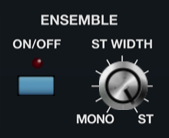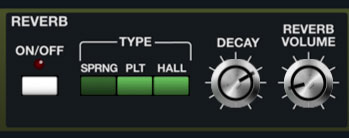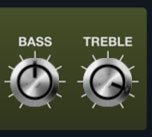Effects
Ensemble
This is the glorious full stereo, dual-voice chorus, just like the original instrument. Don't feel guilty for leaving it on all the time!
This is the glorious full stereo, dual-voice chorus, just like the original instrument. Don't feel guilty for leaving it on all the time!

Unlike other more "watery" chorus implementations, the Jupiter-4 chorus was a little more subtle and "flangey," and we've accurately replicated this in Mercury-4.
On/Off- Enables and disables the chorus effect.
Stereo Width- Sets the audible stereo width of the effect. At a setting of zero, the signal will be mono.
Mercury-4's Tape Echo section reproduces the effect of a vintage "space echo" tape delay. Far from being super-pristine, vintage tape echoes have a lovely limited frequency response, and wow and flutter for a natural thickening effect. We've also replicated the multiple tape head configurations for rhythmic echo effects.

On/Off- Enables and disables the delay effect.
Input knob, VU Meter, and Peak Level LED- Set level near the red for optimal response (the VCA Level slider is best for this). If the Peak Level LED illuminates, back off the input level.
Sync- Engaging the Sync button locks the delays time to master tempo. When engaged, the Rate slider snaps to note values ranging from 1/64th note triplet to 8 beats. Sync mode locks to the tempo in the top toolbar when using the Mercury-4 standalone version or the current project tempo when the plug-in version is used in a DAW.
Heads LEDs and Mode Selector- Determines what combination of the three virtual "tape heads" are currently active; the LEDs illuminate to show the currently active heads. Head 1 is the shortest delay, head 3 is the longest. The time ratios of the heads are like a vintage Space Echo unit as follow:
|
HEAD NUMBER |
TIME MULTIPLIER |
|---|---|
|
1 |
base time |
|
2 |
base time x 1.94 |
|
3 |
base time x 2.85 |
Repeat Rate- Sets delay time, from 1 to 2000 ms (for head 3, the longest one). If the Sync button is enabled, time settings snap to synchronized note values. Note that the tooltip (the popup value display you see when turning a knob) always shows the delay time for head 1. To determine the delay times for heads 2 and 3, you'll need to multiply that by the values shown in the table above - easy! If you stink at math, just click the Sync button, and futz with the Mode Selector and Repeat Rate knobs and we promise something fun will happen.
Intensity- Routes the output to the input for additional repeats, typically referred to as "feedback." We've carefully modeled the unique feedback tones that happen with a real tape echo - they sound awesome (try mapping hardware knob or slider controllers to the Intensity and Repeat Rate knobs for echo feedback madness).
Echo Volume- Sets the volume of the echo signal. The dry level is not affected (this is how classic Space Echo units operate).

On/Off- Enables and disables the reverb effect.
Reverb Type- Allows selection of Spring, Plate, or Hall reverb types.
Decay- Sets the length of reverb release time/size of room.
Reverb Volume- Sets the level of wet signal.

These affect the wet signals of the Tape Echo and Reverb sections. These do not affect the dry signal.
Bass- Sets the overall amount of low frequencies in the wet reverb signal.
Treble- Sets the overall amount of high frequencies in the wet reverb signal.